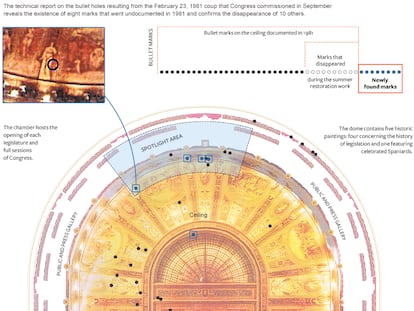Congress discovers eight more bullet holes from 1981 coup
Restoration work had hidden some of the scars from Spanish democracy’s longest night

Eight previously unknown bullet marks have been uncovered in Congress, a grim reminder of the failed coup d’état staged on February 23, 1981 (commonly known as 23-F) by Lieutenant Colonel Antonio Tejero, who held deputies hostage for around 20 hours before releasing everyone unharmed after a night of high tension.
In September of this year, Congress tasked a team of topographers with a mission to “locate and document existing impacts” following restoration work that cost upwards of four million euros. The study also revealed that 10 of the 37 bullet holes catalogued in 1981 have disappeared. Several pieces of renovation work have been carried out on Congress since then that may have affected the bullet marks, the most significant in 1988. But it wasn’t until 1999 that the fact only 33 marks remained was documented. Five more marks disappeared in the renovations carried out over the summer. Of the later disappearances, Congress argues that: “The rush to carry out the work — 20 days in July and the first two weeks in August; installation problems; reduced working space on the wooden structure, as well as the difficulty of accessing 23-F documents because of their classified nature, contributed to the elimination of some marks that none of the people involved in the restoration work were aware of, according to the architect curator’s report.”
The newly discovered marks are located in two of the flat ceiling rosettes, in the dome area and over the spotlight cornice.
Congress also ordered a technical report on the leaks that occurred on September 11, which delayed that day’s parliamentary session for two hours after water flooded the press area and seats designated to Socialist and Plural Left grouping members.
Tu suscripción se está usando en otro dispositivo
¿Quieres añadir otro usuario a tu suscripción?
Si continúas leyendo en este dispositivo, no se podrá leer en el otro.
FlechaTu suscripción se está usando en otro dispositivo y solo puedes acceder a EL PAÍS desde un dispositivo a la vez.
Si quieres compartir tu cuenta, cambia tu suscripción a la modalidad Premium, así podrás añadir otro usuario. Cada uno accederá con su propia cuenta de email, lo que os permitirá personalizar vuestra experiencia en EL PAÍS.
¿Tienes una suscripción de empresa? Accede aquí para contratar más cuentas.
En el caso de no saber quién está usando tu cuenta, te recomendamos cambiar tu contraseña aquí.
Si decides continuar compartiendo tu cuenta, este mensaje se mostrará en tu dispositivo y en el de la otra persona que está usando tu cuenta de forma indefinida, afectando a tu experiencia de lectura. Puedes consultar aquí los términos y condiciones de la suscripción digital.









































